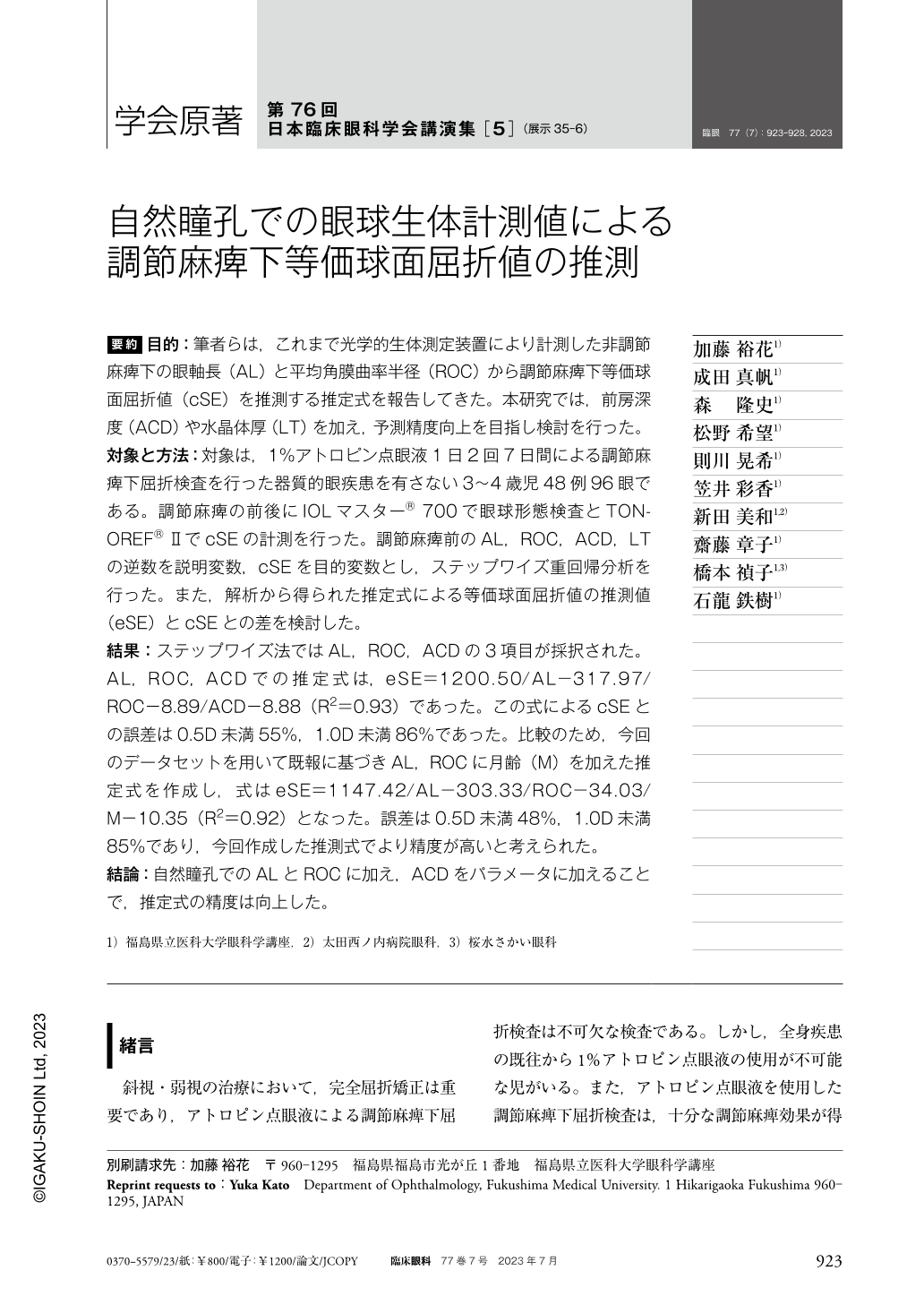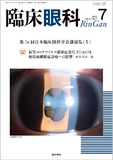Japanese
English
- 有料閲覧
- Abstract 文献概要
- 1ページ目 Look Inside
- 参考文献 Reference
要約 目的:筆者らは,これまで光学的生体測定装置により計測した非調節麻痺下の眼軸長(AL)と平均角膜曲率半径(ROC)から調節麻痺下等価球面屈折値(cSE)を推測する推定式を報告してきた。本研究では,前房深度(ACD)や水晶体厚(LT)を加え,予測精度向上を目指し検討を行った。
対象と方法:対象は,1%アトロピン点眼液1日2回7日間による調節麻痺下屈折検査を行った器質的眼疾患を有さない3〜4歳児48例96眼である。調節麻痺の前後にIOLマスター® 700で眼球形態検査とTONOREF®ⅡでcSEの計測を行った。調節麻痺前のAL,ROC,ACD,LTの逆数を説明変数,cSEを目的変数とし,ステップワイズ重回帰分析を行った。また,解析から得られた推定式による等価球面屈折値の推測値(eSE)とcSEとの差を検討した。
結果:ステップワイズ法ではAL,ROC,ACDの3項目が採択された。AL,ROC,ACDでの推定式は,eSE=1200.50/AL−317.97/ROC−8.89/ACD−8.88(R2=0.93)であった。この式によるcSEとの誤差は0.5D未満55%,1.0D未満86%であった。比較のため,今回のデータセットを用いて既報に基づきAL,ROCに月齢(M)を加えた推定式を作成し,式はeSE=1147.42/AL−303.33/ROC−34.03/M−10.35(R2=0.92)となった。誤差は0.5D未満48%,1.0D未満85%であり,今回作成した推測式でより精度が高いと考えられた。
結論:自然瞳孔でのALとROCに加え,ACDをパラメータに加えることで,推定式の精度は向上した。
Abstract Purpose:We previously reported the prediction formula for estimating the spherical equivalent under cycloplegia based on the axial length(AL)and mean corneal radius of curvature(ROC)measured by an optical biometric device without cycloplegic. We aimed to further improve the estimation accuracy by additional morphological parameters, anterior chamber depth(ACD), and lens thickness(LT).
Subjects and Methods:We included 96 eyes of 48 children(average age in months:45.88±2.40)without structural eye disease, who underwent cycloplegic refraction examination with 1% atropine twice daily for seven days. We measured the morphology using IOL Master® 700(Carl Zeiss)and objective refraction using TONOREF®Ⅱ(Nidek)with and without cycloplegic conditions. Stepwise multiple regression analysis was performed to select effective parameters from AL, ROC, ACD, and LT under non-cycloplegia as explanatory variables and estimated spherical equivalent(eSE)under cycloplegia as the objective variable. In addition, the difference between the eSE and spherical equivalent under cycloplegia(cSE)was assessed.
Results:The three parameters of AL, ROC, and ACD were adopted by stepwise analysis. The estimating formula was calculated as follows. eSE=1200.50/AL−317.97/ROC−8.89/ACD−8.88(R2=0.93). The cSE distributed within less than ±0.5D error range in 55% eyes and within less than ±1.0D error range in 86% eyes. According to our previous report, we calculated an estimating formula with AL, ROC, and age in months(M):eSE=1147.42/AL−303.33/ROC−34.03/M−10.35(R2=0.92). The cSE distributed within less than ±0.5D error range in 48% of eyes and within less than ±1.0D error range in 85% of eyes. Since the percentage of the eyes within less than ±0.5D error range from eSE calculated by the new version formula was higher than that calculated by the previous version formula, the accuracy of the new version formula was deemed superior to that of the previous formula.
Conclusion:The additional parameter ACD in the estimating formula for calculating refractive status under cycloplegia may improve estimation accuracy.

Copyright © 2023, Igaku-Shoin Ltd. All rights reserved.


